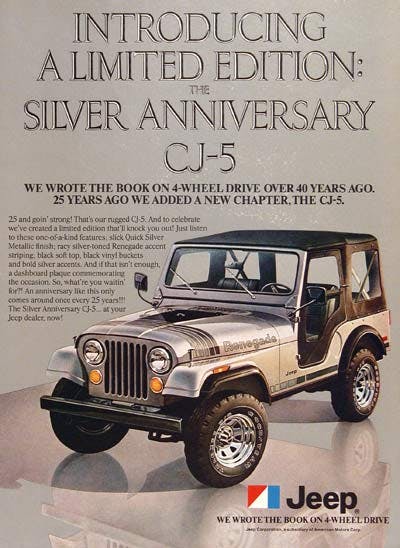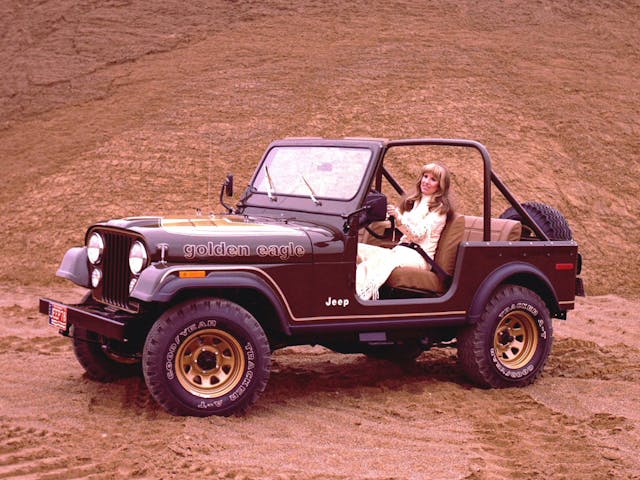The most valuable Willys and Jeep CJs from every generation
Ford’s Model T put America on wheels, but it was the Willys Jeep that first took us off-road. The civilian Willys CJ-2A brought a hard-working vehicular veteran—one of what President Eisenhower commended as “three tools that won the war”—from the battlefield into America’s open fields. It ably adjusted to postwar life, providing farmers and landowners a stout workhorse to till the land, haul the hay, and hit some sweet jumps, probably.
Yes, 40 years of 4×4 wheelin’ following the original Willys MB’s first tour-of-duty cemented the hardworking vehicular war-hero as the commanding officer of off-road fun, too. Each subsequent generation of CJ brought droves of new 4×4 fans into the Jeep family, spawning an entire subculture of Jeep fascination that’s only grown stronger. It’s a Jeep thing, and you probably understand.
Classic “CJ” Jeeps built between 1946 and 1986 are some of the most popular and recognizable classic vehicles in the United States, right up there with the Ford Mustang and Chevrolet Corvette in terms of general appeal. They’re everywhere, but accurately pricing them can prove a mite tricky, owing to the CJ’s inherent willingness to accept modifications as a sponge sucks up spilled soda. Even if you do find one of those rare unmodified CJs, it’s usually either restored or sitting in severely deteriorated condition thanks to quick-rotting soft-tops and poor rust protection.
With this in mind, we worked with Hagerty’s Automotive Intelligence team to pluck the most valuable CJ variants from each standard generation, ignoring ultra-low-production trucks like the original CJ-2 and skipping parallel models like the CJ-6 and later CJ-8.
First Generation (1945-1949): 1945 Willys-Overland CJ-2A

#2 (Excellent) Condition Average Value: $18,000
As the O.G CJ-2A was far more “tool” than “toy,” the 1945-1949 CJ-2A spawned no rare special editions or enthusiast-focused variants to sit at the top of the price index. So, it’s simply the earliest CJ-2As—referred to by marque experts as “Very Early Civilian”—that trade for the most value.
You’d be forgiven if you thought civilian CJ-2As were simply repainted and repurposed mil-spec Willys MBs, as the two Jeeps are almost identical in appearance. The biggest visual differences between the two aren’t big at all; note the CJ-2A’s tailgate and side-mounted spare, along with the CJ-2A’s seven-slot grille to the MB’s nine slots. The same 2.2-liter L-134 Go-Devil four-cylinder with 60 hp and a thick-ish 105 lb-ft of torque carried over from wartime, but the robust T-90 three-speed manual transmission supplanted the MB’s T-84 gearbox.
Of course, the CJ-2A is still a bit of an Army Brat. Many of these super early CJ-2As rolled on remaining stock of military MB componentry, including engine blocks, floating rear axles, and modified MB frames. The real collectibility comes down to the accessories offered for the CJ’s power take-off (PTO) shaft. Dealers offered a variety of powered farm and agricultural implements that hooked to the back or front of the CJ-2A.
Willys-Overland built 214,760 CJ-2As, most of which were rode hard, put up wet, and left to rot when they stopped working. Expect to pay close to $29,000 for the cleanest of the clean CJ-2A in Condition #1, $18,000 for Condition #2 (what we consider the sweet-spot) and $13,700 for those in Condition #3.
Second Generation (1949-1953): 1951 Willys-Overland CJ-3A “Farm Jeep”

#2 (Excellent) Condition Average Value: $19,300
If you thought the differences between the mil-spec Willys MB and the CJ-2A were slight, wait until you park the latter next to a CJ-3A. You’d have to study up with detailed diagrams beforehand if you hope to tell them apart. When differences are expressed in rear wheel-well length, windshield frame dimensions, ignition switch location, and the shape of seat mounting brackets, you know you’re in trouble. Bring in the Jeep nerds!
Mechanically, the CJ-3A is predictably identical to the CJ-2A, carrying the same 2.2-liter, 60-hp four-cylinder and T-90 three-speed manual transmission as its predecessor. However, Willys introduced a new barebones “Farm Jeep” variant in 1951 that prioritized the use of the PTO and the corresponding engine-powered tool attachments.
While not the most effective way to plow a field compared to modern agricultural equipment, these Farm Jeeps hold the most value from the CJ-3A family; rarity, novelty, and genuine usefulness slightly elevate values of Farm Jeeps over the corresponding CJ-3A “Universal Jeep,” with values of a Condition #2 (Excellent) 1951 Farm Jeep trading for $19,300 compared to the $18,100 paid for a standard CJ-3A in equitable condition.
Third Generation (1953-1968): 1953-1954 Willys CJ-3B “Farm Jeep”

#2 (Excellent) Condition Average Value: $19,500
Finally, an appreciable difference between generations. The majority of the CJ-3A carries over for the new “3B” model, apart from the mechanical guts up front. Gone is the legendary L134 “Go Devil” engine, replaced by the similar F134 “Hurricane” 2.2-liter four-cylinder. With the updated F-head configuration, power ranged between 72-75 hp and 112-114 lb-ft, depending on compression ratio.
The Hurricane was taller than the discontinued Go Devil engine, so the CJ-3B’s hood height is noticeably increased when compared to the CJ-3A; this is by far the easiest way to pick out a CJ-3B from a crowd of 2As and 3As.
Again, the rarely preserved Farm Jeep variant of the CJ-3B branch holds the highest value, with the very best (#1 Condition) Farm Jeep 3Bs commanding $30,800 to a standard #1 Condition 3B’s $29,800. If you stick to #2 Condition, prepare to scribble a $19,500 check.
Fourth Generation (1954-1983): 1978 Jeep CJ-5 Silver Anniversary

#2 (Excellent) Condition: $36,500
You read that right—the CJ-5 remained in full production for a whopping 29 model years. With this stunning longevity, it’s no wonder the CJ-5 is where the Willys ends and the modern idea of what a “Jeep” is begins. It’s one of the most aesthetically versatile classic SUVs you can buy; with skinny tires and painted steelies, you’ve got a bigger, more capable, and more comfortable CJ-3B. Conversely, cram it full of big, fat tires and a foam-wrapped rollbar, and it looks very bit like a full-scale TYCO R/C car, purpose built for romping up dunes and shuffling surfboards.
Three decades of production spawned some rather desirable limited models, the princeliest of them being the Silver Anniversary edition. Created to celebrate 25 years of CJ-5 production in 1979, AMC allotted one CJ-5 Silver Anniversary to each Jeep dealer. Official documentation claims 1,000 units were built, but the official Silver Anniversary registry presents compelling evidence to the true production figure sitting around 850 units.
Each Silver Anniversary arrived with model-specific Quick Silver metallic paint, contrasted by black striping, black soft top, unique spare tire cover, black vinyl seats, “Renegade” hood decals, and an all-important dash plaque. For the freshest of fresh (#1 Condition) Silver Anniversary with the 304 cubic-inch AMC V-8, expect to hand over $48,100; this drops to $36,500 for #2 Condition, and $20,900 for #3 Condition.
Fifth Generation (1976-1986): 1977-1980 Jeep CJ-7 Golden Eagle

#2 (Excellent) Condition: $36,300
Compared to the contemporary CJ-5, the CJ-7 was bigger, taller, and longer, offering buyers more amenities and comfort. The CJ-7 signaled the end of the line for the enduring “CJ” family tree, the enduring mil-spec heritage replaced by the YJ-generation Jeep Wrangler in 1987.
The CJ-7 did not go quietly into the night. Jeep blessed it with a healthy selection of special editions. The most valuable and, uh, distinctive of all CJ-7s is the dramatic Golden Eagle edition. Zero points awarded for correctly guessing how the Golden Eagle earns its wings—er, name.
Yes, the CJ-7 channels some its inner Trans-Am with that big ‘ol bird motif on the hood, complemented by optional gold wheels, body stripes, wheel lip extensions, roll-bar lights, and a front bumper in your choice of black or chrome. Inside that tan Levi’s soft-top, look for a sport steering wheel, faux engine-turned gauge plate, and front bucket seats and rear bench seats upholstered in tan Levi’s vinyl. Yep, that Levi’s.
Excited? You must be a child of the ‘70s. Rustle up $55,700 for the nicest Golden Eagle in the world (#1 Condition), or a more reasonable $36,300 for one in #2 Condition.



right on the money
Can’t argue with any of the above. I do wonder why, after some of the selling prices seen on sites like Bat, Hagerty STILL hasn’t added valuation for the Jeep/Jeepster Commando models (C-101 & C-104). Built from 1967-1973, I’d bet some of these models (Hurst and SC1) in #1 condition would give the CJ models a run for their money. They were produced in much lower numbers, making them rare. C’mon Hagetry, it isn’t ALL about Bronco’s and Scouts!
CJ7 6cl,automatic,A/C,Tilt wheel,Hardtop. Question is should I replace bad Engine for a 1999 Jeep, 6 Cyl and 5;Speed Trans. Not Sue if Blown Rad is rebuildable yet. Keep Original or make change?